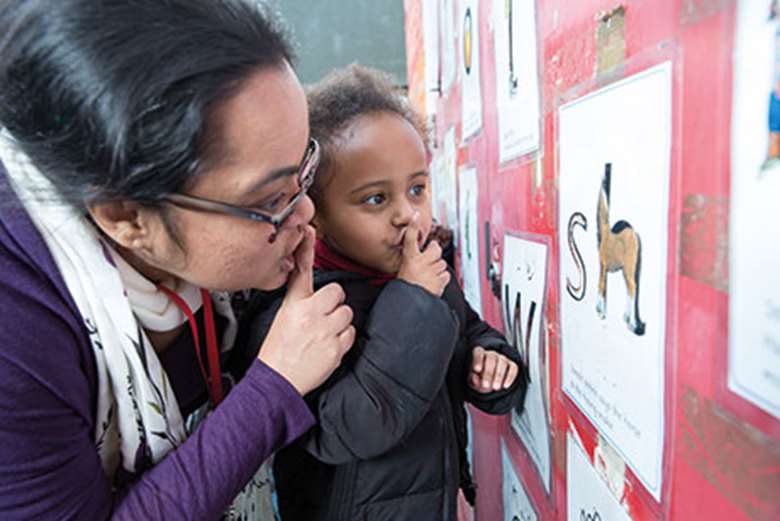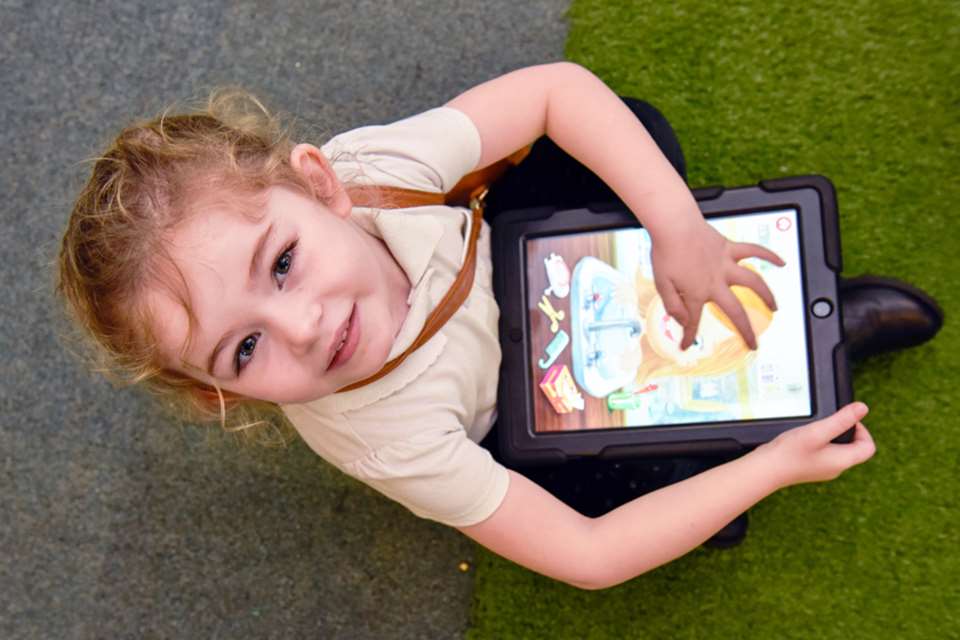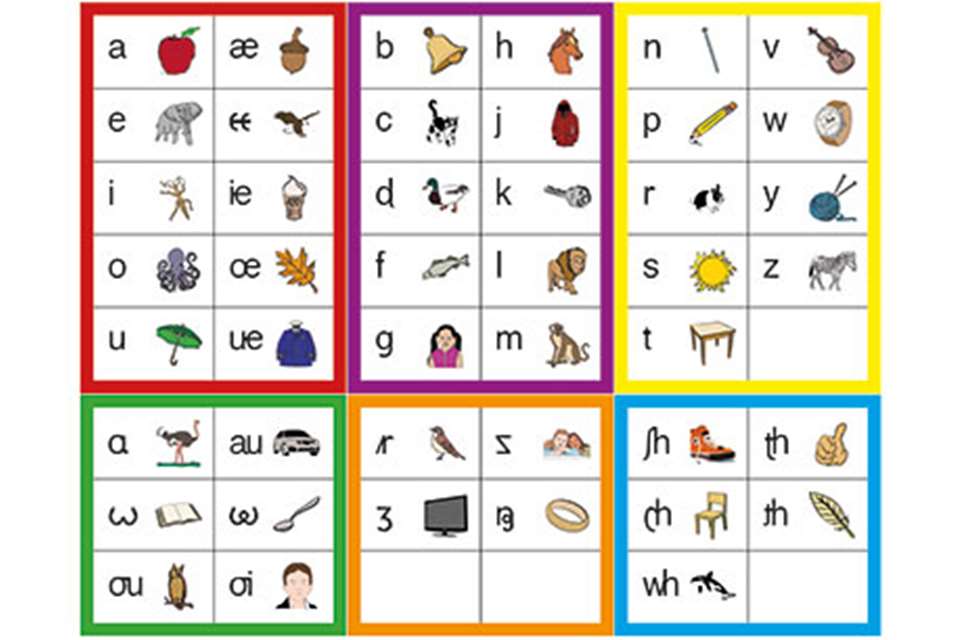EYFS Best Practice: All about… literacy
Annette Rawstrone
Monday, February 5, 2018
Effective literacy teaching involves much more than synthetic phonics, explains Annette Rawstrone

Download the PDF of All About...Literacy
I want to see Reception classes looking like fairy tales, with lots of reading opportunities and provocations to draw children in and stir their imaginations,’ says Pam Jarvis, a chartered psychologist specialising in human development at Leeds Trinity University. ‘The first thing is for children to want to pick up books and want to access the code of reading, rather than be presented with a bunch of synthetic phonics which don’t make sense.’
The rich learning environment for teaching children to read described by Dr Jarvis, and supported by many early years practitioners, is seen by some to be at odds with the Bold Beginnings report published by Ofsted in November. The report on Reception class teaching has caused concern that Ofsted is advocating a move away from a play-based curriculum to a more formal approach. It states the core purpose of Reception is the teaching of reading, including systematic synthetic phonics.
Since its publication, Ofsted has tried to allay sector concerns about the report, while holding to its original argument that literacy should be central to the early years curriculum (see More information).
‘If you have a broad interpretation of literacy then, yes, it needs to be at the heart of the curriculum along with numeracy. But my interpretation of literacy is very broad and includes speaking, listening, verbal reasoning, not just reading and writing,’ says Sue Bodman, member of the International Literacy Centre at UCL.
‘Teachers need to make it appropriate and meaningful for the child. Otherwise, if a child does not want to read, even if they can, then they won’t engage. The thirst for learning is brought to life by a good teacher.’
MEANINGFUL EXPERIENCES
While it is agreed that synthetic phonics are an important part of teaching children to read and helping them gain an understanding of the alphabetic code, it should not be the sole way that children are taught.
‘To do so would suggest a limited understanding of reading and what becoming a reader involves,’ says Sue McGonigle, lecturer in primary education at UCL Institute of Education and co-creator of website Lovemybooks. Children need a rich range of meaningful, enjoyable reading experiences and a range of strategies to support their developing independence.’
She adds that settings should enable children to ‘step inside stories through play’ – role play, small-world play and puppets. They need well-stocked reading areas where children can have books read aloud or browse and revisit stories, with their sense of language and phonological awareness supported by playful approaches including song and rhyme.
The Progress in International Reading Literacy Study (PIRLS) 2016, published in December, ranked England joint eighth out of 50 countries, with average scores higher than in previous years, showing an increase in reading performance. School standards minister Nick Gibb has attributed England’s increased scores in part to the use of synthetic phonics in schools. However, Ms McGonigle notes that the PIRLS report uses a test of comprehension and it is not possible to conclude that increased phonics instruction has had a direct bearing on improved results.
It is also suggested that the results coincide with a greater emphasis on stories and rhymes in schools. Dr Jarvis adds that we still don’t know enough about how literacy works in the brain. We just have clues, and emphasis on phonics does not necessarily make children fluent readers.
Northern Ireland, which uses linguistic phonics, fared even better, in fourth position. Louise Jackson, curriculum consultant at Early Excellence, thinks this could be a better approach for the UK, given that English is not a phonic language. ‘Linguistic phonics puts language learning within a meaningful context – less focus on memorising letter sounds and rules; more focus on listening and attention, playing with language, using it in context,’ she explains.
Although she adds that synthetic, linguistic and analytic phonics are all approaches that will help children to learn to read, one should not be given higher status. ‘In a classroom where children speak lots of languages, they will have very different experiences of hearing and using speech sounds,’ she says. ‘It is not helpful to identify one common starting point – we live in a multilingual society.’
SOUNDS AND SINGING
Bold Beginningspromotes starting teaching children to read from the first week of the new academic year, but Jude Twani, regional development manager at Early Excellence, recommends delaying formal phonics and ensuring that the foundations are laid through dedicating time to Phase 1 in Letters and Sounds – aural blending, segmenting, alliteration and rhyming – rather than launching into SATPIN (the first letters and sounds that are taught).
She suggests going on listening walks, playing musical instruments, trying to replicate sounds and singing rhymes. ‘Leaping too early into the more formal instruction of phonics can disempower children and result in practitioners constantly having to go over areas with some children,’ she explains. ‘If a practitioner is too caught up in grapheme and phoneme correspondence they can miss out the important rhyme and alliteration bits.’
She believes that there is good and bad teaching of phonics, rather than good or bad phonics schemes. ‘What matters is the skills of the practitioner in their delivery and their confidence. As is stated in the EYFS, it’s important for adults to tune into the children, not to talk at them,’ she says.
‘There can also be a danger if practitioners narrow down and become very dependent on one system. Children need to be independent learners and need to use a range of different strategies such as sight words, using picture clues, reading for context and phonic strategies. The best teachers still employ all of that and Bold Beginnings is not averse to that. Phonetically sounding out a word in order to decode and “read” it does not mean that they understand it. It needs to be coupled with comprehension, otherwise it is a meaningless activity.’
Dr Bodman warns against teachers becoming over-reliant on textbooks and worksheets instead of seeing how the children work and adapting and scaffolding their learning. Using schemes to teach phonics can also lead to children being taught in ability groups, which she believes is acceptable in moderation. ‘Children working towards the same learning objectives may meet to do some work together but they also need the opportunity for peer learning and flexible groups which value building language, social and cultural,’ she says. ‘Children should be able to work with any partner they choose, not just one from their same reading group.’
But Ms Jackson warns that ability groups can have a negative impact on self-esteem, growth mindsets and learning.
In her experience, the use of phonics schemes can put up a barrier between school and parents, with parents afraid to read with their children in case they are doing it out of line with the scheme. She has also found it can lead parents to pressure children to move through the scheme’s stages.
Ms Twani adds, ‘There is a danger that in a practitioner’s eagerness they can think that if they do more then it will be more effective.’ She believes some schemes expect an ‘awful lot’ of young children’s concentration. In contrast, she recalls observing a 10-minute phonic focus on the sound ‘O’ and seeing focused children leading to the impact of the short session flowing throughout the morning, with children discussing having ‘O’ in their name or using it at the writing table.
‘Bad phonics teaching is when it’s not alive and meaningful for children. Phonics needs to be done but children need to be convinced why they need to do it,’ she says. ‘It’s important to tune into real life as much as possible – there’s no point asking children to point to a yacht if they don’t know what one is. Putting phonemes in the sandpit does not put them in context, but an adult pointing them out in meaningful print does.’
MEANINGFUL CONTEXTS
The National Curriculum guidance recommends that children have ‘ample practice in reading books which are closely matched to their developing phonic knowledge and knowledge of common exception words’. Ms McGonigle believes this has led to a market for graduated decodable texts, with quality varying enormously. ‘Unless balanced with lots of hands-on experience with real books, this will inevitably limit children’s view of books and the pleasures that reading can bring,’ she warns. ‘There is no reason why young readers should not also be presented with words that are not decodable and beyond the high frequency, “tricky” word lists. Children are fascinated with words like “dinosaur”, for example, and will enjoy recognising and reading words which interest them in meaningful contexts.’
Ms Twani agrees that children need a ‘diet of really good books’ – decodable books alongside children’s story and picture books. ‘What’s needed is to learn the love of reading. This is not instilled by magic,’ she says. ‘It’s getting comfortable and enjoying a book together and building an emotional connection with it.’
CASE STUDY
The Spinney Primary School, Cambridge
‘We’re a book-rich school with a lovely little library. There’s a book corner in every classroom and we’re committed to developing a culture of children experiencing joy through reading,’ says head teacher Rachel Snape.
‘We believe that if children are happy and having fun then they can learn, which is why we focus closely on the social and emotional aspects of learning when children start in Reception and why we use StoryTime phonics as it introduces young children to reading engaging books in an enjoyable context, rather than an overly formal approach.’
‘It’s the third year that we’ve used the StoryTime phonics programme and we’ve got 100 per cent in the phonics screening check over the past two years. Fifty per cent of our children have English as an additional language and we didn’t used to get these high scores. It works because the children are reading “real” books – such as Nick Sharratt’s Shark in the Parkand Snail Trailby Ruth Brown – rather than scripted texts.
‘At the same time they are being systematically introduced to phonemes. Children are captivated by the stories. It’s the antithesis of the way I taught phonics over 15 years ago, which was dry and calling out sounds. Rather than learning phonemes without context, the children can immediately apply their phonic knowledge to reading and can make meaning from the stories. Children access high-quality texts which relate to phonemes and split digraphs and they are engaged in the great stories and beautiful pictures.
‘The daily 20-minute sessions are fun and the teachers can be creative, make thematic links with the books and show the children hand signals for different sounds to kinaesthetically reinforce their memory. They do funny actions related to the sounds, which helps children to retain information better than simple rote learning. Phonics, direct reading, writing and books all come together authentically through the StoryTime programme rather than having phonic sessions that are separate, stressful and dry.
‘We also use PM Benchmark Kits to gauge children’s reading ability and to give the children four to five books of the right free-reading level to read at home with their family to help improve their confidence, autonomy and self-esteem. Children as young as four consider themselves readers because they can access books, which makes them feel happy and empowered. They understand how fabulous books are and love reading.’
CASE STUDY
St Matthias School, Bethnal Green, east London
‘We want our children to leave Reception being able to read both for understanding and pleasure. If they can decode but don’t like books then they’re not a reader. If children love books, enjoy turning the pages but can’t read then that’s fine at the beginning, but by the end of Reception they should be able to read some books,’ explains head teacher Clare Sealy.
‘Hearing loads of stories with really rich language and beautiful illustrations and loving storytime along with direct teaching of synthetic phonics are equally important for learning to read. We use the Read Write Inc scheme because it’s well researched, the children enjoy it and progress well and the materials are easy for trained staff to use.
‘Reception children have a daily phonics session, lasting around 30 minutes, and a literacy slot which focuses on quality story books for a two-week period, such as Owl Babies by Martin Waddell. We put emphasis on reading together, drama, exploring the plot and shared writing. Direct teaching is mixed with child-initiated learning and we provide free-flow activities based on books and cosy reading areas in classrooms as well as outside. We encourage parents to read with their children and send home a Read Write Inc book and a story book for them to share.
‘We like to teach children in smaller groups and will put children together that are of a similar level, but this is very fluid. Smaller groups make it easier for children to pay attention and it needs to be quiet for children to blend sounds and for the teacher to assess. Having groups of a similar level means children aren’t daunted by those who are finding it easier or bored because they can do it. Some children pick up the sounds and blending quickly while others take months, but once they have mastered it they’re ready to fly.
‘Some practitioners regard synthetic phonics as all drill and kill and boring, but the Characteristics of Effective Learning say that children learn through energy and fascination, and we need to model that. If teachers think it’s a boring chore then children will do too.
‘We need to get across that learning a sound links to mastering text, which is the most amazing thing ever. Children go into Year 1 seeing themselves as readers.’
MICHAEL ROSEN: IN MY VIEW
What are the essentials of teaching children to read?
I hope you’re using the word ‘read’ to mean ‘read with understanding’ and not just ‘read words out loud’. Children need to ‘get’ the fact that we use letters and combinations of letters to cue us up to make sounds. Children need to get the idea that reading is not just a matter of reading out loud, but means reading for meaning.
Children need to get the idea that reading is not just a matter of reading words, but it’s about reading sequences of words, where the ‘syntax’ of written language and the particular usages of written language can be found.
Because a lot of prose (written language which is not poetry or plays) has a structure that isn’t very much like speech, this written style has to be ‘got’ by young readers.
One of the great bridges between spoken and written language is poetry, song and drama. That’s because these forms are often similar to speech, and/or are easy to learn off by heart.
What is a rich learning environment for literacy?
Stories, poems, rhymes, drama, posters, labelling, along with plenty of discussion and talk used in play, planning, reflection and in relation to books, stories and rhymes.
Should synthetic phonics be the main way to teach children to read?
Synthetic phonics teaches children to decode. In order to read, children have to find out how words and sequences of words have meaning. It’s not just a matter of being able to decode the words in reading schemes. The argument from advocates of synthetic phonics is that you must ‘first’ do phonics and ‘then’ read for meaning. Any of us who’ve helped our children learn to read know that at least sometimes, though it can be often, children ‘get’ that some of the matching of letters to sounds is done via meaning.
I can give an example. My children did phonics but got stuck on the word ‘would’. They could sound out the ‘w’ and the ‘ld’ part of the word, but couldn’t ‘blend it’. They read on further along the sentence and passage and then went back and ‘got’ that it was ‘would’. They learned it part phonically, part ‘look and say’ and part from meaning and context. This seems OK to me.
I learned to read by a form of phonics that wasn’t systematic synthetic phonics. It was done through stories, cartoons, letter-sound repetition, syllables, limited vocabulary. All the while, my parents and brother were reading to me.
What are your messages to practitioners?
I believe in horses for courses. Whatever gets a child over the line to ‘reading with understanding’ and ‘reading for pleasure’. Whatever works.
MORE INFORMATION
Bold Beginnings, www.gov.uk/government/publications/reception-curriculum-in-good-and-outstanding-primary-schools-bold-beginnings
‘Ofsted expands onBold Beginnings messages in sector meeting’ and ‘Ofsted’s Gill Jones begins drive to clarify Bold Beginnings report, www.nurseryworld.co.uk
PIRLS, http://pirls2016.org
Read Write Inc, www.ruthmiskin.com/en
StoryTime phonics, www.tts-group.co.uk
PM Benchmark Kits, https://shop.scholastic.co.uk/series/1080
PDF RESOURCES








